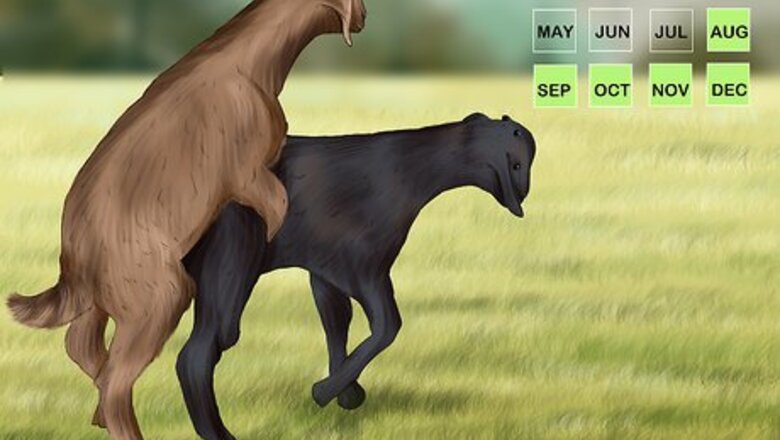
views
- Goats breed in autumn, so once the days start getting shorter, watch for the signs that your doe is in heat and your buck is in rut.
- If you don't want keep bucks on your farm, rent one from a stud farm or from someone you know.
- The easiest way to breed your goats is to pair them up in the same pen or pasture and let nature take its course.
- You can also use artificial insemination (AI) when your doe goes into heat by administering semen into your doe with an insemination gun.
- If your doe doesn't go into heat about 21 days after mating or insemination, she's probably pregnant, and you'll have a kid about 150 days after conception!
Timing the Mating Cycle
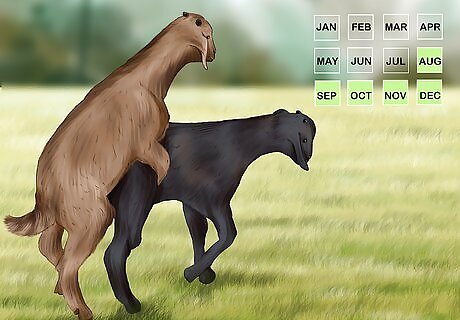
Plan to breed when the days start getting shorter. Unlike some domesticated animals, goats still tend to breed seasonally. The reduced daylight hours during autumn signal that it's mating season, so that the kids can be born after the oncoming winter. In the Northern Hemisphere, this means that August to December is “prime time” for goat mating. Goat breeding can happen year-round with the help of hormone treatments and artificial insemination, but usually only larger goat-raising operations resort to these methods.
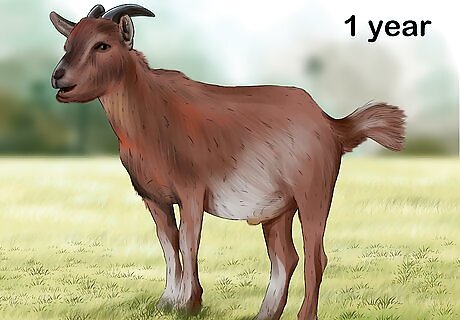
Determine your buck's mating potential by his age. Uncastrated male goats (bucks) are sexually mature by 5 months of age, and sometimes as early as 3-4 months. So, if you want to control the breeding process, keep any bucks over 3 months old separate from your does! A buck that's 6 months to 1 year old can mate with about 10 does per season. A healthy 2 year old buck may be able to mate with 25 does per season. By 3 years of age, a buck in good health can mate with up to 40 does per season. However, just because a buck can mate often doesn't mean it should. Be judicious when deciding how often to breed your goat to ensure the health of the goats and the kids.
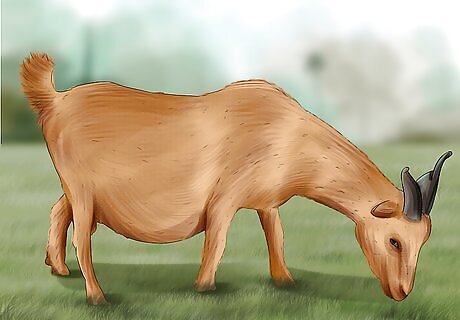
Make sure your doe is large enough to manage pregnancy. In most cases, a doe born in the spring can breed in the fall (at age 4 months or more), so long as she weighs more than 80 pounds (36 kg). However, it's better to wait until the doe is at least 1 year old and more than 100 pounds (45 kg). A larger doe will be better able to carry twins or triplets, so keep this in mind especially if multiple births are common in your goats' pedigrees.
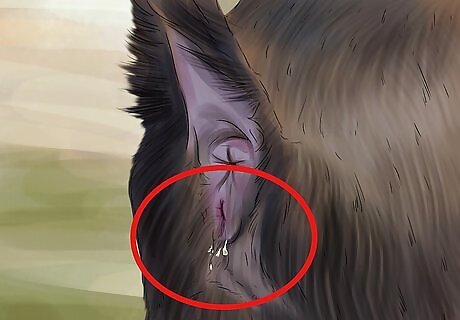
Watch for signs that the doe is in heat. Does go into heat (or estrus) roughly every 21 days, for stretches of 2-3 days. To recognize estrus, look for indicators such as mucus discharge from the vulva, a swollen vulva, increased bleating, frequent tail wagging, excessive pacing, and an increased interest in any bucks nearby — or even anything that smells like a buck.
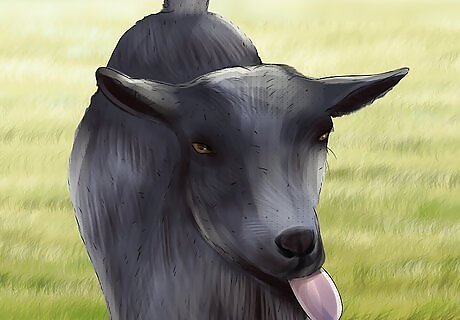
Look for changes that indicate the buck is “in rut.” Bucks that are eager to mate are said to be “rutting” or “in rut.” The most obvious sign is a pungent odor — during this time bucks will urinate all over themselves, from head to tail. You may also notice more aggressive behavior and demonstrative facial maneuvers, like lip and tongue flapping and blubbering sounds. To humans, the smell of a buck “in rut” is hard to handle, but it is very appealing to does in heat.

Entice a doe that needs encouragement to go into heat. Some does won't go into heat unless there are bucks in the area. Try putting a “rutting” buck within sight and smell of the doe. This will usually solve the problem quickly. Be careful when placing animals in heat near each other but in separate pens. The goats may injure themselves trying to get to each other. You should supervise them closely and check to make sure the fences are safe and free of defects. Alternatively, you can use a “billy rag.” Rub a cloth over a “rutting” buck, then wave it around the doe and keep the rag in her proximity. The pungent scent is often enough to do the trick.
Bringing Goats Together for Mating
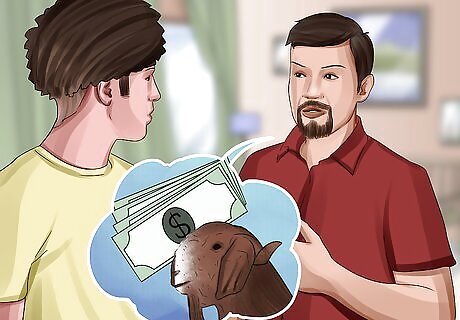
Rent bucks for convenience and genetic diversity. Does and wethers (castrated males) are usually easier to care for (and smell better!), so some people choose not to keep any bucks. In this case, you can “rent” a buck from a neighbor, friend, or stud farm when the time is right. Look for bucks with detailed and high-quality pedigrees, and utilize different bucks to increase the genetic diversity of your herd. Some breeders advise strongly against mating bucks and does with substantial size differences, while others have not experienced problems with pregnancy or birthing in these cases. Consult your vet and experienced breeders about specific cases.
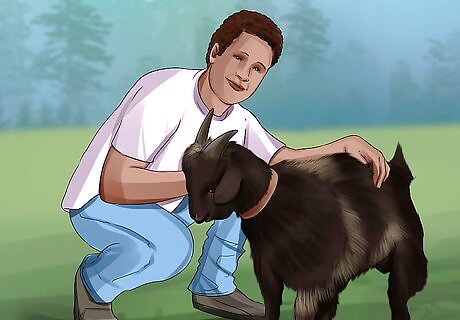
Raise your own bucks for greater control over the conditions. If you raise your own bucks, you know everything about their background, temperament, living conditions, health history, and so on. You also won't have to scramble as much to get the goats together when the time is right. Keep bucks separate from does except during mating times, but don't raise them alone. Goats are social creatures, so it's best to provide one or more wethers as friends if you have just one buck. Caring for a buck can cost $150 USD per year, or roughly the cost of 5 mating rentals (which often run around $30 USD). Use the costs in your area to determine the economic comparison between owning and renting.
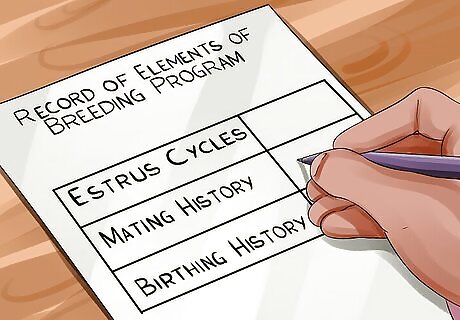
Keep detailed records of all elements of your breeding program. Create a spreadsheet or similar document that details the estrus cycles, mating and birthing history, and any relevant health or behavior issues regarding your does. Likewise, record details on the pedigree, mating numbers and history, and inheritable traits for any bucks you own or rent. Good records can help limit excessive in-breeding. For instance, siblings should not mate, and parent-child mating should be permitted rarely if at all. In-breeding of less direct relatives can actually be a good thing, so long as you pair up goats with good pedigrees and characteristics, and don't breed ones with undesirable histories or traits.
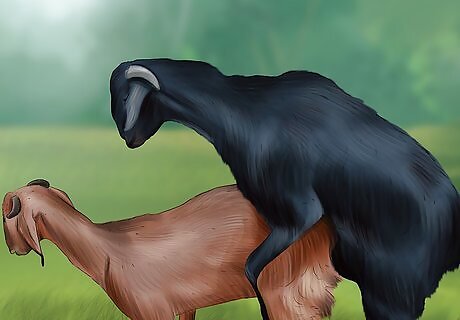
Set up the “date” and let things happen naturally. Pair up your chosen doe in heat and buck “in rut” by putting them together alone in the same enclosure. Often, they will get down to business right away, with the buck mounting the doe several times over a period of about 20 minutes, or perhaps up to an hour. A disinterested doe will run away and fend off the buck. This means the time isn't right and you should try again another time. An “old farmer's tale” says that you can bet on a successful copulation if the female's back arches during the mounting. But use this pearl of wisdom at your own risk!
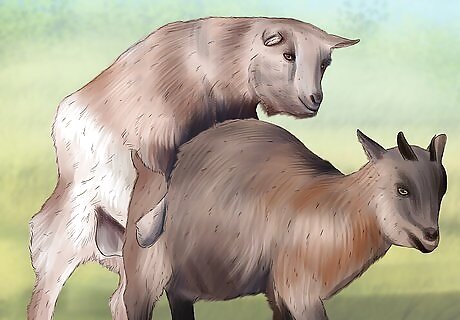
Let the chosen mates pasture together for a less controlled process. If you don't want to set up specific dates and confirm every detail of the mating process, you can use a more free-wheeling approach. Just leave the doe and buck alone together for a few days while the time is right, and they'll almost certainly copulate numerous times. This method makes predicting a successful impregnation or timing out a due date more challenging, however.
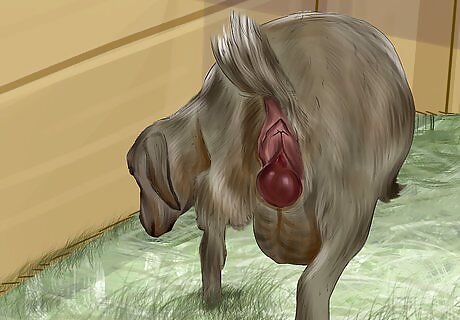
Pay close attention to the doe's next scheduled estrus cycle. Roughly 21 days after mating the doe with the buck, keep an eye out to see if the doe goes into heat again. If she doesn't, this is a very strong indicator that the doe is pregnant. Go ahead and start making plans for the pregnancy and birthing processes. For even greater certainty, you can have a vet do an ultrasound. But this can be costly and is unnecessary in most cases.
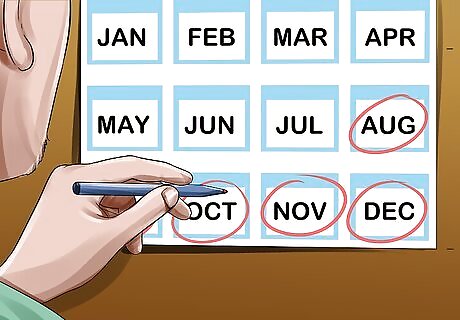
Calculate the likely birth date. Goats have an average gestation cycle of 150 days. So, when you're confident that your doe is pregnant, move forward on your calendar 150 days from the date of mating. The birth will most likely occur on or within a few days of this due date. Keeping detailed records and supervising the mating process makes predicting due dates accurately much easier.
Breeding via Artificial Insemination (AI) Instead
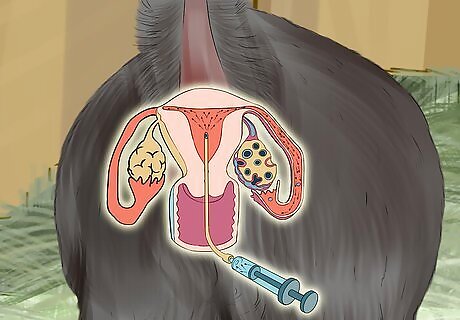
Use AI for total control of the breeding process. Artificial insemination is a good option if you don't have any high-quality bucks in your herd and can't find good, affordable ones to rent nearby. Also, AI lets you absolutely ensure a specific bloodline, and leaves less of the process up to nature's whims. You can hire someone to complete the AI process for you, or buy the necessary equipment to do it yourself. The necessary AI equipment can cost $500 USD, so factor this in when comparing the cost of hiring someone to do the job for you.
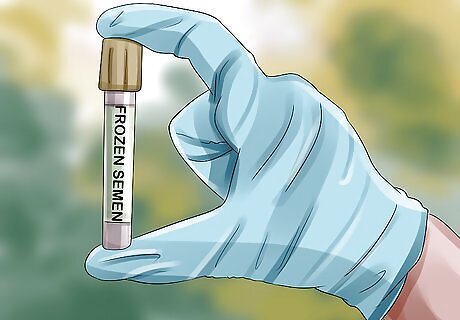
Buy frozen semen. Make sure the seller has ample documentation regarding the buck's health history, personality, and family tree. Also confirm that the sample has been recently frozen and is not more than 6 months old. And, if at all possible, spend some time with the buck to get a firsthand impression of his health and temperament. If you're not using the semen right away, transfer it immediately to your own liquid nitrogen storage tank, according to the tank's instructions. It's very important that you properly store and handle the semen. It should not be thawed until you are ready to use it. Otherwise, the pregnancy may not take or thrive. If you want to administer semen from one of your bucks using AI, you can buy an artificial vagina that collects the sample. However, it will only be viable for 2-3 hours.
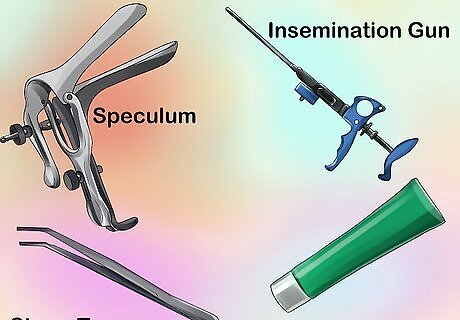
Invest in the necessary equipment for frozen-sample AI. Other than the liquid nitrogen tank (which can cost $400-$450 USD), you'll need a list of supplies both basic and specialized. These include the following: speculum (25 x 175 mm for doelings or 25 x 200 mm for does); AI light or headlight; sterile lubricant (non-spermicidal) insemination gun (for “straws” containing frozen semen); straw tweezers; reeding stand or similar means to restrain the doe thaw box; paper towels; straw cutter; thermometer
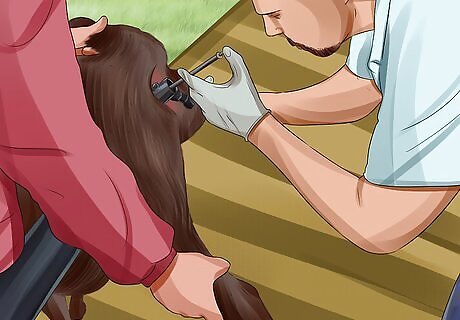
Use AI promptly when the doe goes into heat. AI is most effective when it occurs as soon as possible after the doe shows signs of being in heat. Use the length of your doe's typical estrus cycle as your guide. If the doe typically goes into heat for: 24 hours or less, do AI as soon as your recognize estrus. 36 hours, complete AI within 12 hours of estrus signs appearing. 48 hours, do AI within 24 hours. 72 hours, do AI within 48 hours.

Have someone the doe knows do the procedure, if possible. Artificial insemination tends to be more successful with a calm doe, which often means having a familiar person do the procedure. Therefore, consider doing the procedure yourself, if you feel confident in your abilities. If not, be present to keep the doe calm while a vet or more experienced goat breeder does the procedure.
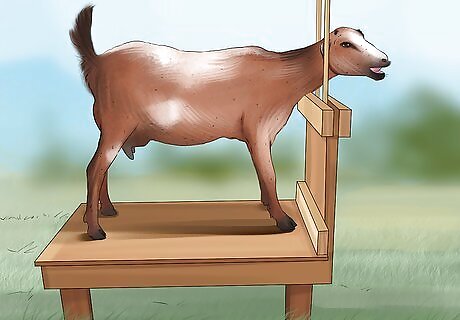
Restrain the doe for insemination. A dedicated breeding stand is the best option for this process, but other restraining enclosures may serve your purposes. Talk to your supplier for advice on the equipment you have, and purchase a breeding stand if they advise it.
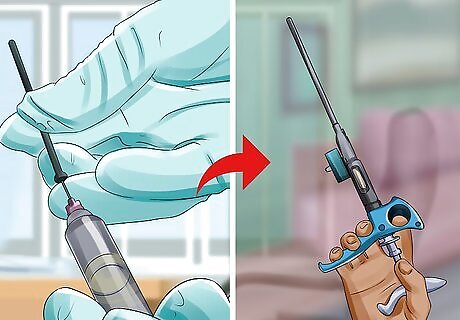
Thaw the semen and load the insemination gun. Thawing instructions can vary by producers of the “straws” containing the samples, but generally you'll remove the chosen straw from the liquid nitrogen with straw tweezers, then place the straw in a thaw box with 95 °F (35 °C) water for about 30 seconds. After this quick thaw, you'll dry the straw off with paper towels and immediately load the insemination gun. Insemination guns also vary, but usually you'll pull the plunger back several inches/centimeters, add a cotton plug against the plunger, and then load the straw.
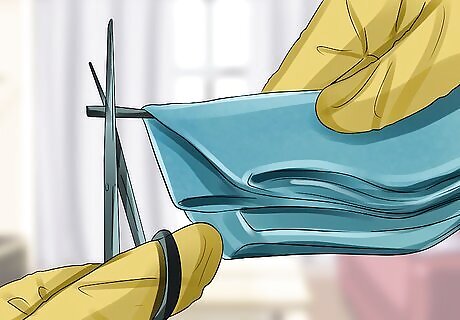
Cut and cover the loaded straw. The sealed end of the straw should be cut with the included straw cutter. Immediately after, place the included cover sheet and secure it in place with the accompanying O-ring.
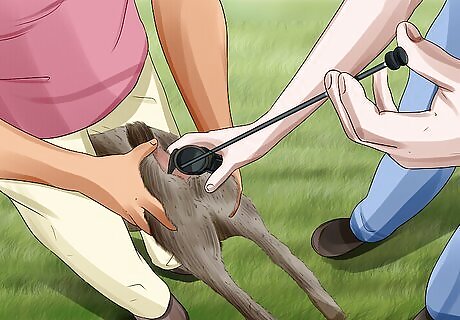
Lubricate and insert the speculum. Turn on your headlamp or AI light, lubricate the speculum, and clean the doe's vulva with a paper towel. Insert the speculum at an upward angle into the vulva. Locate the cervix visually and center the speculum over the cervix opening. Identify the cervix by looking for its purple-red color, and the white mucus that will coat and surround it if the doe is in heat. If the doe refuses to stand up, have an assistant lift her hindquarters for you before trying to insert the speculum.
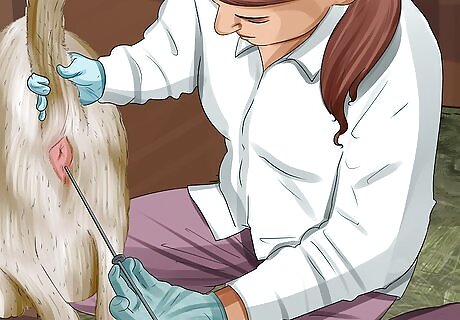
Insert the insemination gun and deposit the semen. The AI gun inserts into the speculum, and from there you'll thread it into the cervix opening. Gently work the gun into the cervix, but don't penetrate more than 1.5 inches (3.8 cm). Slowly depress the plunger to deposit the semen. Then slowly remove the gun and speculum. For visual reference, draw a ring (with a red marker, for instance) around the AI gun's cover sheath, 1.5 inches (3.8 cm) from the gun's tip. Carefully record the time and other info into your breeding journal or database.
Overseeing Pregnancy and Birthing
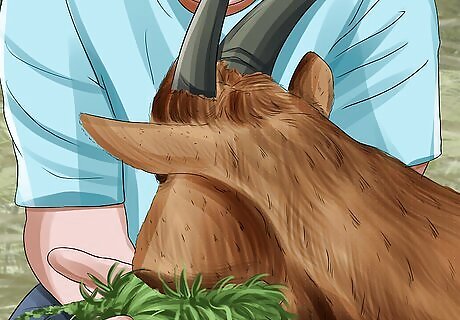
Care for the doe as normal until 6 weeks before the due date. For most of the pregnancy, the doe can be fed the same amount and types of food and cared for in the same manner as usual. If you've been milking the doe, you can keep up that habit as well.
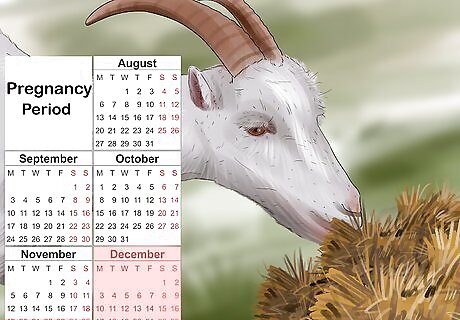
Adjust the goat's diet during the last 6 weeks of pregnancy. As the due date approaches, the doe needs more nutrient-dense food that takes up less space in her increasingly-crowded belly. Over the period of a week or two, reduce the amount of hay you're providing while increasing the amount of grain. The doe should be eating very little hay as the due date draws near. Consult your vet for guidance on what and how much to feed your goats in general, and how to transition the diet of your pregnant goat. Your vet may also recommend that you give the pregnant doe mineral supplements.

Move the doe to a birthing stall 2 weeks before the due date. Goats can give birth in the field if that's your preference, and any other does or wethers typically won't cause any problems. However, using a dedicated birthing stall makes it easier to observe and assist as the due date approaches. During these last two weeks, you'll notice that the doe's udder and vulva will begin to swell. The swelling will become even more substantial just before the goat is ready to give birth. The doe will become restless and agitated, and her back legs will likely start to quiver as the birthing process is about to begin.
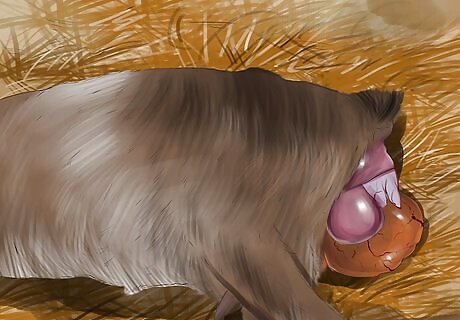
Observe a healthy birth and give minimal assistance. Normally, the kid will come out nose and front feet first, while possibly still in the protective membrane. It usually takes about 15 minutes for the kid to fully emerge. Use a clean rag or paper towels to make sure the kid's nose and mouth are clear, then let it nurse with its mother. If the goat is carrying twins or triplets, there will likely be a 15-20 minute pause between births. In addition to warm water and clean rags, you can find lists of recommended birthing supplies at https://www.britishgoatsociety.com/about-us/breeding/ and https://www.farmingmagazine.com/livestock/goats/breeding-goats/.

Assist yourself or get help if there are problems. If the kid seems to be emerging slowly, you can grab onto its exposed front legs and hold them in place (without pulling on them) so they don't retract back in as a contraction ends. The placenta should emerge within an hour, and detach on its own — don't pull on it. If it doesn't appear within an hour or detach within 10 hours, call your veterinarian. Also contact the vet if: There is significant discharge from the doe's vulva, but birthing doesn't follow soon after. There has been active labor (with obvious straining) for 30 minutes with no results. Only the kid's head, front legs, or tail appears. The kid has a fever over 104 °F (40 °C) and is lethargic or refuses to feed. The doe's udder is hot and swollen, and the milk is clotted and won't flow easily.
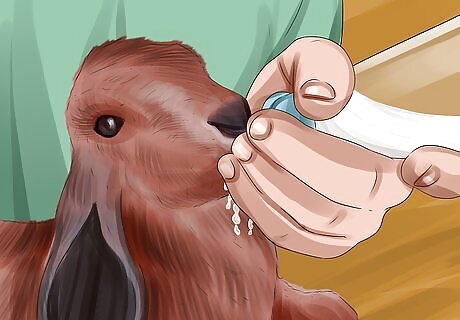
Provide care for the newborn kid(s) as needed. If the baby goat or goats were born without incident and are feeding normally, there isn't a great deal that you need to do. Consult with your vet or experienced goat breeders for kid care advice. Bottle feed kids who aren't effectively feeding with -- or are being neglected by -- their mother. Consult your vet if you need guidance. For the safety of your herd and yourself, remove a kid's horn buds at about a week of age. Have an expert do this if you are untrained. Start giving vaccinations at about one month of age, and check kids regularly for fevers (101.5 °F (38.6 °C) is normal) and other health issues.














Comments
0 comment